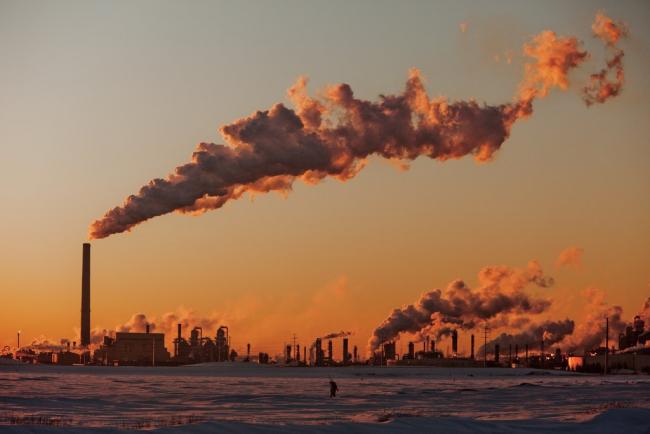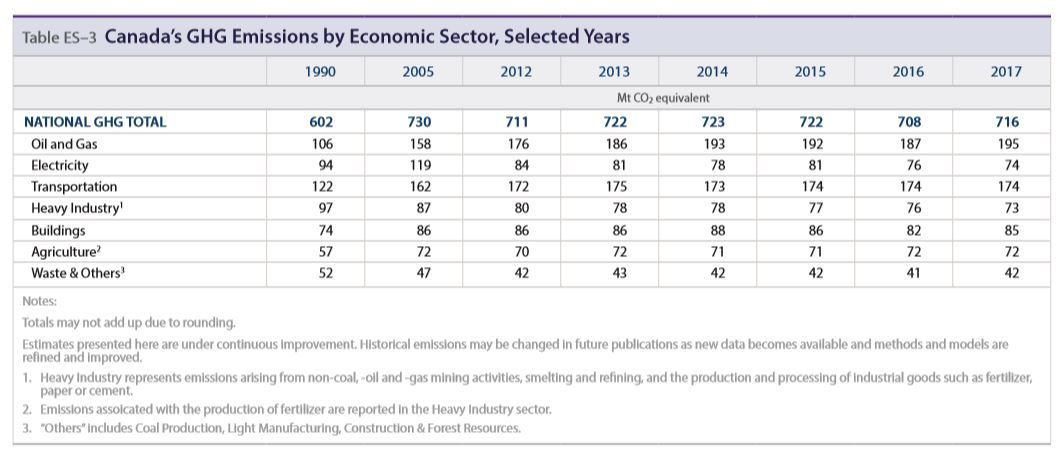Articles Menu

Pollution from fossil fuels in Canada continues to grow by staggering amounts, with the oilsands sector alone responsible for more carbon pollution than all of B.C. or Quebec in 2017, says the federal government in its latest climate change report to the United Nations.
The newest edition of Canada’s National Inventory Report, covering data up to two years ago, shows that the oil and gas sector was responsible for 195 million tonnes, or megatonnes (Mt) of greenhouse gas emissions in 2017, up eight Mt from 2016.
The figures were compiled before the major elements of the Trudeau government’s plan to crack down on emissions, like its price on carbon pollution and its tightened regulations on coal-fired power plants and on methane leaks, have come into effect.

The oilsands, a region in Alberta and Saskatchewan that constitute almost all of Canada’s 173 billion barrels of proven oil reserves, generated 81 Mt of pollution in 2017, making up 41 per cent of the sector’s emissions.
That is larger than all the pollution generated by the entire economies of British Columbia that year, at 62 Mt, or Quebec's at 78 Mt. It is also larger than emissions reductions that have been seen in other parts of the country.
Ontario’s emissions, for example, dropped by 45 Mt since 2005 mostly because of the closing of coal plants, that happened under provincial Liberal governments between 2005 and 2014. Quebec, meanwhile, experienced an 8.4 Mt decrease, and B.C. a one Mt decrease from 2005.
Alberta's carbon pollution increased by 18 per cent from 2005 to 2017, "primarily as a result of the expansion of oil and gas operations," the report stated.
The extraction of bitumen and synthetic crude oil in Canada’s oilsands rose by 158 per cent since 2005, and with it, a 43 Mt increase in emissions from fuel consumption by oil and gas extraction.
The growth has occurred as Western Canada crude oil available for export more than doubled since 2010, according to the National Energy Board (NEB).
Canada has the world's third largest oil reserves after Saudi Arabia and Venezuela. The oilsands are deposits of a heavy, tar-like oil that is mixed with clay, deep beneath the boreal forest in Western Canada.
Most of the crude oil produced in Western Canada is a heavy oil that is high in sulphur. The NEB has said this oil is "lower quality" than lighter crudes because they yield a lower amount of products like gasoline.
Heavy, high-sulphur crude is also more costly to refine, and requires additional steps and costs to extract, including large amounts of energy and water.

The NDP government of Alberta Premier Rachel Notley, which was defeated in Tuesday night's provincial election, had promised to set an absolute cap of 100 Mt of carbon pollution from the oilsands. Premier-designate Jason Kenney's United Conservative Party is expected to undo Notley's climate policies, including her cap on oilsands pollution.
But the sector, which has represented about two per cent of Canada's economy according to federal government estimates, was responsible for 400,000 direct and indirect jobs in Alberta in 2016. It has historically opposed proposals to introduce tough national climate change policies.
Overall, energy use — including things like fuel combustion and leaks from the oil and gas industry, mining, manufacturing, and the transportation sector — accounted for 583 Mt or 81 per cent of Canada’s total greenhouse gas emissions.
"Increases in emissions from the tarsands are undoing all the progress being made in other sectors," said Keith Stewart, senior energy strategist with Greenpeace Canada, in a statement.
"If we are serious about protecting communities from climate-fueled floods, wildfires and other extreme weather, the last thing Canada should be doing is building new pipelines to expand oil production and exports. Either we act like this truly is a crisis that threatens our health and survival, or we sleepwalk towards disaster. It's as simple as that and our politicians are currently choosing the second option."
Canada’s overall emissions rose by 8 Mt from 2016 to 2017, from 708 Mt to 716 Mt. The report refers to this as a “fluctuation” and says there were competing factors.
“Canada’s climate plan is working, and the overall trend in emissions is downward toward 2030,” said Environment and Climate Change Minister Catherine McKenna in a statement sent to National Observer.

Today’s report confirms Ontario has decreased emissions by 22% since 2005, while the rest of Canada has increased output. Ontarians have paid a significant cost for these efforts, yet the federal government continues to ask us to pay more than our fair share.
Statement below:
Successive Liberal governments in Ontario shut down all five of the province's remaining coal plants, with 19 coal-fired units in total before losing the 2018 election to the Progressive Conservatives.
On Tuesday, Ontario's environment minister, Rod Phillips, whose government is currently locked in a court battle with Ottawa over carbon pricing, pointed to those McGuinty and Wynne-era reductions.
"Today’s report confirms Ontario has decreased emissions by 22 per cent since 2005, while the rest of Canada's output continues to increase," he said.
In addition to Ontario, Quebec and B.C., other provinces and territories also saw a reduction in emissions from 2005. Nova Scotia dropped from 23 Mt to 16 Mt, New Brunswick dropped 20 Mt to 14 Mt, and Northwest Territories dropped from 1.6 Mt to 1.3 Mt.
Photo: A shot of Fort McMurray, Alberta in 2012, by Kris Krüg from Flickr